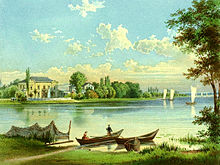Emil Cohn (publisher)
Emil Cohn (born September 17, 1832 in Posen (today Poznań), † June 21, 1905 in Berlin ) was a German publisher .
Life
Emil Cohn studied law after graduating from school and worked at the court in Grätz (near Posen) during his legal clerkship . Here, in the birthplace of the publisher Rudolf Mosse , he also met his future wife Leonore Mosse, Rudolf Mosse's sister.
Rudolf Mosse offered Emil Cohn a job in his advertising business in Berlin after he graduated. On January 1, 1871, 39-year-old Cohn became a partner in Rudolf Mosse's advertising expedition . A little later Mosse and Cohn decided to found their own daily newspaper. The first edition of the Berliner Tageblatt appeared on January 1, 1872 . In the years that followed, Mosse-Verlag developed into one of the largest publishing houses in Berlin. In 1882 Emil Cohn joined the Society of Friends .
Cohn was mainly involved in organizational and legal matters at Mosse-Verlag. In 1884 he ended his activity at Mosse-Verlag and in 1885 acquired the left-liberal Berliner Volks-Zeitung, founded by Franz Duncker in 1853 . Cohn carried on the paper for twenty years. In 1904 he sold to the Mosse publishing house. Emil Cohn died a year later at the age of 73. He was buried in the Jewish cemetery on Schönhauser Allee .
Also in 1885, Cohn had acquired the Nieder Neuendorf estate, which his children sold four years after his death in 1909 to AEG , which set up one of its largest operating facilities there. Residential houses were also built on the site (today Cohn'sches Viertel). The manor house survived the end of the Second World War and was only demolished in 1961/65.
children
Leonore and Emil Cohn had the sons:
- Martin Cohn (1872-1933), who did his doctorate in law, married the non-Jew Klara Muks and in 1921 changed his name to Martin Carbe. Both died by suicide . Martin Carbe committed suicide in Locarno in 1933 and his wife in Berlin in 1947. They had two sons who left Germany before 1930.
- Fritz Simon Cohn (born September 23, 1875 in Berlin), who established himself as a lawyer and worked as a consultant to Mosse OHG. An episode with Fritz Cohn in Berlin's Apollo Theater around 1900 led to the creation of the song and the character of little Cohn . After his marriage in 1919, Fritz Cohn renounced his inheritance from the family business. He lost his wife in the 30's. He was deported from Berlin to the Theresienstadt concentration camp and murdered there on September 2, 1943.
Individual evidence
- ↑ Entry on the Nieder Neuendorf manor on burgeninventar.de ( memento of the original dated June 29, 2008 in the Internet Archive ) Info: The archive link was inserted automatically and has not yet been checked. Please check the original and archive link according to the instructions and then remove this notice.
- ↑ Joseph Walk (ed.): Short biographies on the history of the Jews 1918–1945. Edited by the Leo Baeck Institute, Jerusalem. Saur, Munich 1988, ISBN 3-598-10477-4 , p. 52.
- ↑ Theodor Wolff, Bernd Sösemann (eds.): Diaries Theodor Wolff 1914-1919: The First World War and the emergence of the Weimar Republic in diaries, editorials and letters from the editor-in-chief of the "Berliner Tageblatt" and co-founder of the "German Democratic Party". H. Boldt, 1984, p. 517.
- ^ Elisabeth Kraus: The Mosse family. German-Jewish bourgeoisie in the 19th and 20th centuries , CH Beck, 1999, p. 537
- ^ Helmut Fritsch: Emil Cohn: emancipated German Jew, Jewish bourgeois German, landowner in Nieder Neuendorf 1885-1905 and testator in Hennigsdorf. His life and the fate of his heirs during the Nazi era , self-published 2005
- ^ Cohn Fritz Simon: Death certificate, Ghetto Terezín , digitized version on Holocaust.cz
literature
- Elisabeth Kraus: The Mosse family - German-Jewish bourgeoisie in the 19th and 20th centuries. Munich 1999, p. 176ff.
Web links
- Literature by and about Emil Cohn in the catalog of the German National Library
- Article about Emil Cohn in the HWB-Journal (PDF file; 505 kB)
- Klaus Euhausen: The early industrial development of Hennigsdorf. (PDF)
| personal data | |
|---|---|
| SURNAME | Cohn, Emil |
| BRIEF DESCRIPTION | German publisher |
| DATE OF BIRTH | September 17, 1832 |
| PLACE OF BIRTH | Poznan , Poland |
| DATE OF DEATH | June 21, 1905 |
| Place of death | Berlin |

